What is Interaction Design?

- 1.4k shares
- 2 weeks ago
Interaction Design (IxD) is the design of interactive products and services in which a designer’s focus goes beyond the item in development to include the way users will interact with it. Thus, close scrutiny of users’ needs, limitations and contexts, etc. empowers designers to customize output to suit precise demands.
For UX designers, “Interaction Design” is the axis on which our work revolves (i.e., the design of human interaction with digital products); however, the term also applies to understanding how people interact with non-digital products.
“Interaction Design is the creation of a dialogue between a person and a product, system, or service. This dialogue is both physical and emotional in nature and is manifested in the interplay between form, function, and technology as experienced over time.”
- John Kolko, Author of Thoughts on Interaction Design (2011)
Designers’ work in IxD involves five dimensions: words (1D), visual representations (2D), physical objects/space (3D), time (4D), and behavior (5D).
Here, we'll explain what interaction design is, show some useful models, and, finally, we'll briefly describe what an interaction designer usually does. Interaction design is an important component within the umbrella of user experience design. Interaction design can be understood in simple, but not simplified, terms. It's the design of the interaction between users and products. Most often, when people talk about interaction design,
they talk about software products like apps or websites. The goal of interaction design is to create products that enable the user to achieve their objectives in the best way possible. If this definition sounds broad, that's because the *field* is rather broad. The interaction between a user and a product often involves elements like aesthetics, motion, sound, space and many more. And, of course, each of these elements can involve even more specialized fields,
like sound design, for the crafting of sounds used in user interactions. As you might already realize, there's a huge overlap between interaction design and UX design. After all, UX design is about shaping the experience of using a product. And the most part of that experience involves some interaction between the user and the product. But UX design is more than interaction design. It also involves figuring out which experiences will be the most relevant for your users, the best way of creating them
and the best way of validating the design. For that, you also need user research, personas, user testing and so on. The 5 Dimensions of Interaction Design is a useful model to understand what interaction design involves. The first dimension is *words*. Words, and especially the ones we use in interactions – like the button label on the image – should be meaningful and simple to understand. They should communicate information to users, but not so much information that they overwhelm the user. The second dimension is *visual representations*.
This concerns graphical elements like images, typography and icons that users interact with. Icons and images usually supplements the words used to communicate information to users. Even if you don't know Chinese, you can probably tell the camera app from the map on this Android interface because you recognize the icons. The third dimension relates to the *physical objects* that users use to interact with a product. This could be things like a laptop, a mouse, a touchpad or a smartphone.
It also relates to what kind of physical space the user interacts in. For instance, is the user standing in a crowded train while using the app on a smartphone? Or sitting at a desk in the office, surfing the website? These factors all affect the interaction between the user and the product. The fourth dimension is *time*. While this dimension might sound a little abstract, it refers to aspects of the interaction that unfold over time, such as animation, videos and sounds. Motion and sounds play a crucial role in giving
visual and audio feedback to users' interactions. For instance, look at the feedback an iPhone gives you when you send a message. The small animation and the swoosh sounds give you subtle feedback that your message has been sent. You can also think of time in relation to the amount of time a user spends interacting with the product. Can users track their progress or resume their interactions sometime later? – and so on. The fifth dimension is *behavior*,
which basically relates to the user side of the interaction, both in terms of how they interact with the product and how they *react* to the product. In relation to interaction, the previous dimensions come together to define how users perform actions and operate the product. The user's *reaction* obviously also relates to whether you've designed the previous four dimensions to create a compelling and positive experience for the user. So, how do interaction designers work with the five dimensions to create meaningful interactions? To get an understanding of that, we can look at Usability.gov's
important questions interaction designers ask when designing for users. The first is "What can a user do with their mouse, finger or stylus to directly interact with the interface?" This helps us define the possible user interactions with the product. The answer to this question obviously depends on the type of product. So, you have to look at the *action possibilities* of the particular product you're working with. For instance, an iPad has a number of predefined gestures available to the user and designer to take advantage of.
The second question is "What about the appearance, such as color, shape and size, give the user a clue about how it functions?" This helps us give users clues about what behaviors are possible. If you look at the cutout from Interaction-design.org, you can see that we use the color blue to tell our users where text is interactive. We also use shading and a square shape to indicate to users that there's a button that can be pressed. The third question is if your error messages provide a way for the user to correct the problem
or explain why the error occurred. This lets the user anticipate and mitigate errors. If you create error messages that make no sense to the user, they'll quickly become frustrated with your product. The fourth question asks what feedback a user gets once an action is performed. Asking this allows us to ensure that the system provides feedback in a reasonable time after user actions. In the example here, Twitter provides feedback to
the user both when they input information right – with the little checkmark – and when the input information wrong – by providing information about what the problem is. The fifth question is "Are the interface elements a reasonable size to interact with?" Questions like this help us think strategically about each element used in the product. Users interact with devices of many different sizes. And what you can interact with on a laptop is not necessarily the same as what you can interact with on a phone.
The final question asks if familiar or standard formats are used. Standard elements and formats are used to simplify and enhance the learnability of a product. Play control icons like the play and pause on the Apple TV remote are a good example of a widely known standard. So, what do interaction designers do? Well, it depends! For instance, if the company is large enough and has enough resources, it might have separate jobs for UX designers and interaction designers.
In a large design team, there might be a UX researcher, an information architect, an interaction designer and a visual designer, for instance. But, for smaller companies and teams, most of the UX design job might be done by 1–2 people who might or might not have the title of "Interaction Designer". In any case, we can divide a lot of the tasks interaction designers handle in their daily work into two categories: *Design Strategy* and *Wireframes and Prototyping*. When interaction designers work with design strategy,
they are concerned with what the *goals* of the user are and, in turn, what interactions are necessary to *achieve* these goals. Depending on the company, interaction designers might have to conduct user research to find out what the goals of the users are before creating a strategy that translates into interactions. How interaction designers work with wireframes and prototypes again depends on the job description of the company. But most interaction designers are asked to create wireframes that layout the interactions in the product.
Sometimes, interaction designers might also create interactive prototypes and high-fidelity prototypes that look exactly like the actual app or website. Here, we've provided you with an overview of what interaction design is. But if you're interested in finding out more about interaction design, we encourage you to read our encyclopedia chapter called "Interaction Design – brief intro" by Jonas Lowgren. The chapter provides a great introduction to the field as well as other references where you can learn more.
Learn more about the 5 factors of interaction design and the kind of work IxD involves.
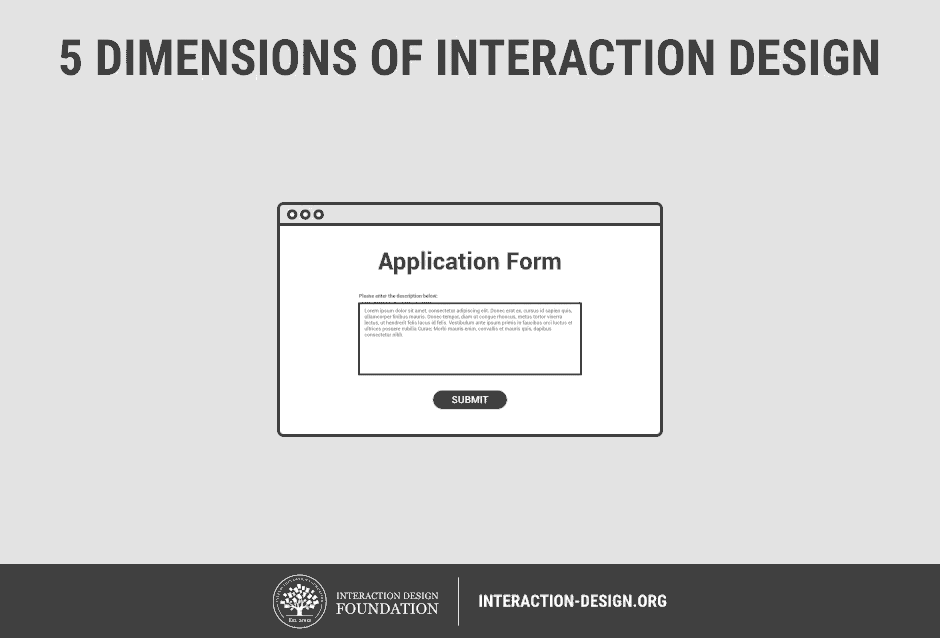
IxD’s five dimensions were first defined by a professor at London’s Royal College of Art, Gillian Crampton Smith, and a senior interaction designer, Kevin Silver. The dimensions represent the aspects an interaction designer considers when designing interactions:
Words (1D) encompass text, such as button labels, which help give users the right amount of information.
Visual representations (2D) are graphical elements such as images, typography and icons that aid in user interaction.
Physical objects/space (3D) refers to the medium through which users interact with the product or service—for instance, a laptop via a mouse, or a mobile phone via fingers.
Time (4D) relates to media that changes with time, such as animations, videos and sounds.
Behavior (5D) is concerned with how the previous four dimensions define the interactions a product affords—for instance, how users can perform actions on a website, or how users can operate a car. Behavior also refers to how the product reacts to the users’ inputs and provides feedback.
Interaction designers utilize all five dimensions to consider the interactions between a user and a product or service in a holistic way. Specifically, we use them to help envision the real-world demands of a usership in relation to a design not yet introduced. For example, designers of an app that must process data at high speed in order to find results inside a mass-transit system (a subway/metro) will face accommodating the constraints of underground commuters – cramped spaces, fast journeys, dead zones, etc.
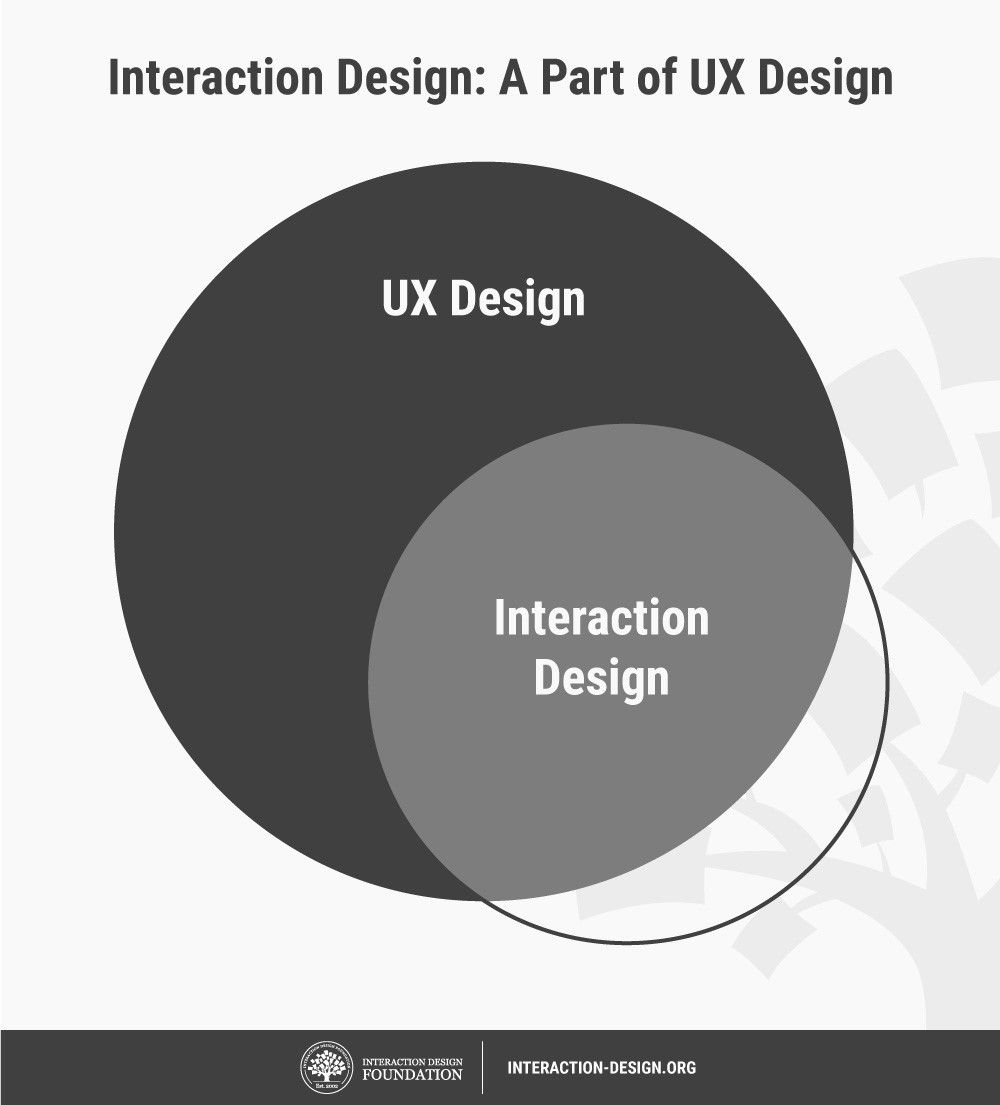
The term “interaction design” is sometimes used interchangeably with “user experience design”. That’s understandable, considering interaction design is an essential part of UX design. Indeed, UX design entails shaping the experience of using a product, and a big part of that experience involves the needed interaction between the user and the product. However, UX design goes far beyond that. UX designers’ working world is concerned with the entire user journey, including aspects of branding, design, usability and function. Conversely, the central role of “interaction designers” targets the moment of use and how to improve the interactive experience. Thus, interaction design, or IxD, is pivotal in the realm of the user experience, since the moment of use is the acid test of a design, where the designer’s manipulation of the five dimensions must offer users a satisfactory—if not better—experience. If users find themselves hindered by impractical features, such as text-heavy notifications or overlong animations, are put off by the aesthetics, or the responsiveness of the design fails to match their needs in the context, the design will fail, regardless of the brand behind it. The IxD of a product reflects its absolute value.
Read usability.gov’s questions to consider when designing for interaction here.
UX Matters has a great article by Kevin Silver on the 5 dimensions of interaction design here.
You can learn much more about what interaction design is and how to design interactions in the Interaction Design Foundation’s online courses.
Interaction design, a pivotal component of user experience design, emphasizes creating engaging products that facilitate user objectives, involving multifaceted elements like aesthetics, motion, sound, and space. It stands out from traditional design disciplines by focusing on user interaction and overall product experience beyond just visual aesthetics. To explore interaction design’s intricate principles, models, and critical role in developing user-centric designs, watch our detailed video and read this comprehensive book chapter.
Here, we'll explain what interaction design is, show some useful models, and finally, we'll briefly describe what an interaction designer usually does. Interaction design is an important component within the umbrella of *user experience design*. Interaction design can be understood in simple, but not simplified, terms as the design of the interaction between users and products. Most often when people talk about interaction design, they talk about software products like apps or websites.
The goal of interaction design is *to create products that enable the user to achieve their objectives in the best way possible*. If this definition sounds broad, that's because the field is rather broad. The interaction between a user and a product often involves elements like *aesthetics*, *motion*, *sound*, *space* and many more. And, of course, each of these elements can involve even more specialized fields
like sound design for the crafting of sounds used in user interactions. As you might already realize, there's a huge overlap between interaction design and UX design. After all, UX design is about shaping the experience of using a product. And the most part of that experience involves some interaction between the user and the product. But UX design is more than interaction design. It also involves figuring out: 'Which experiences will be the most relevant for your users?'; the best way of creating them, and the best way of validating the design.
For that, you also need *user research, personas, user testing, and so on*. The *five dimensions of interaction design* is a useful model to understand what interaction design involves. The first dimension is *words*. Words and especially the ones we use in interactions like the button label on the image should be meaningful and simple to understand. They should communicate information to users, but not so much information that they overwhelm the user. The second dimension is *visual representation*. This concerns graphical elements like
images, typography and icons that users interact with. Icons and images usually supplement the words used to communicate information to users. Even if you don't know Chinese, you can probably tell the camera app from the map on this Android interface because you recognize the icons. The third dimension relates to the *physical objects* that users use to interact with the product. This could be things like a laptop, a mouse, a touchpad or a smartphone. It also relates to what kind of *physical space* the user interacts in.
For instance, is the user standing in a crowded train while using the app on a smartphone or sitting at a desk in the office, surfing the website? These factors all affect the interaction between the user and the product. The fourth dimension is *time*. While this dimension might sound a little abstract, it refers to aspects of the interaction that unfold over time such as animation, videos and sounds. Motion and sounds play a crucial role in giving visual and audio feedback to users' interactions.
For instance, look at the feedback an iPhone gives you when you send a message. The small animation and the swoosh sound gives you subtle feedback that your message has been sent. You can also think of time in relation to the *amount* of time a user spends interacting with the product. Can users track their progress or resume their interaction sometime later? And so on. The fifth dimension is *behavior*, which basically relates to the user side of the interaction, both in terms of how
they interact with the product and how they react to the product. In relation to interaction, the previous dimensions come together to define how users perform actions and operate the product. The user's reaction obviously also relates to whether you've designed the previous four dimensions to create a compelling and positive experience for the user. So, how do interaction designers work with the five dimensions to create meaningful interactions? To get an understanding of that, we can look at usability.gov's important questions
interaction designers ask when designing for users. The first is: What can a user do with their mouse, finger, or stylus to directly interact with the interface? This helps us to find the *possible user interactions* with the product. The answer to this question obviously depends on the type of product, so you have to look at the *action possibilities* of the particular product you're working with. For instance, an iPad has a number of pre-defined gestures available to a user and designer to take advantage of.
The second question is: What about the appearance, such as color, shape and size, give the user a clue about how it functions? This helps us give users clues about what behaviors are possible. If you look at the cutout from interactiondesign.org, you can see that we use the color blue to tell our users where text is interactive. We also use shading and the square shape to indicate to users that there's a button that can be pressed. The third question is if your error messages provide a way for the user to correct the problem
or explain why the error occurred. This lets the user anticipate and mitigate errors. If you create error messages that make no sense to the user, they'll quickly become frustrated with your product. The fourth question asks what feedback a user gets once an action is performed. Asking this allows us to ensure that the system provides feedback in a reasonable time after user actions. In the example here, Twitter provides feedback to the user both when they input information right – with a
little check mark – and when they input information wrong, by providing information about what the problem is. The fifth question is: Are the interface elements a reasonable size to interact with? Questions like this help us think strategically about each element used in the product. Users interact with devices of many different sizes, and what you can interact with on a laptop is not necessarily the same as what you can interact with on a phone. The final question asks if familiar or standard formats are used.
Standard elements and formats are used to simplify and enhance the learnability of a product. Play control icons like the play and pause on the Apple TV remote are a good example of a widely known standard. So, what do interaction designers do? Well... it depends. For instance, if the company is large enough and has enough resources, it might have separate jobs for UX designers and interaction designers. In a large design team, there might be a UX researcher, an information architect, an interaction designer and a visual designer, for instance.
But, for smaller companies and teams, most of the UX design job might be done by one to two people who might or might not have the title of 'interaction designer'. In any case, we can divide a lot of the tasks interaction designers handle in their daily work into two categories: *design strategy* and *wireframes and prototyping*. When interaction designers work with design strategy, they are concerned with what the goals of the user are and, in turn, what interactions are necessary to achieve these goals?
Depending on the company, interaction designers might have to conduct *user research* to find out what the goals of the users are before creating a strategy that translates into interactions. How interaction designers work with wireframes and prototypes again depends on the job description of the company. But most interaction designers are asked to create wireframes that lay out the interactions in the product. Sometimes interaction designers might also create interactive prototypes and high-fidelity prototypes
that look exactly like the actual app or website. Here, we've provided you with an overview of what interaction design is. But if you're interested in finding out more about interaction design, we encourage you to read our encyclopedia chapter called 'Interaction Design - Brief Intro' by Jonas Löwgren. The chapter provides a great introduction to the field as well as other references where you can learn more.
An interaction designer crafts the experiences users have with products, focusing on optimizing user interaction and functionality. They utilize various elements like aesthetics, motion, sound, and space, ensuring that products are user-friendly and meet user needs effectively. They consider the Five Dimensions of Interaction Design: words, visual representations, physical objects, time, and behavior, to create meaningful interactions.
The interaction designer also works with design strategies, wireframes, prototyping and sometimes conducts user research to understand user goals better. For more insights on what interaction designers do, watch our video, which comprehensively explains the role and components of interaction design in detail.
Here, we'll explain what interaction design is, show some useful models, and, finally, we'll briefly describe what an interaction designer usually does. Interaction design is an important component within the umbrella of user experience design. Interaction design can be understood in simple, but not simplified, terms. It's the design of the interaction between users and products. Most often, when people talk about interaction design,
they talk about software products like apps or websites. The goal of interaction design is to create products that enable the user to achieve their objectives in the best way possible. If this definition sounds broad, that's because the *field* is rather broad. The interaction between a user and a product often involves elements like aesthetics, motion, sound, space and many more. And, of course, each of these elements can involve even more specialized fields,
like sound design, for the crafting of sounds used in user interactions. As you might already realize, there's a huge overlap between interaction design and UX design. After all, UX design is about shaping the experience of using a product. And the most part of that experience involves some interaction between the user and the product. But UX design is more than interaction design. It also involves figuring out which experiences will be the most relevant for your users, the best way of creating them
and the best way of validating the design. For that, you also need user research, personas, user testing and so on. The 5 Dimensions of Interaction Design is a useful model to understand what interaction design involves. The first dimension is *words*. Words, and especially the ones we use in interactions – like the button label on the image – should be meaningful and simple to understand. They should communicate information to users, but not so much information that they overwhelm the user. The second dimension is *visual representations*.
This concerns graphical elements like images, typography and icons that users interact with. Icons and images usually supplements the words used to communicate information to users. Even if you don't know Chinese, you can probably tell the camera app from the map on this Android interface because you recognize the icons. The third dimension relates to the *physical objects* that users use to interact with a product. This could be things like a laptop, a mouse, a touchpad or a smartphone.
It also relates to what kind of physical space the user interacts in. For instance, is the user standing in a crowded train while using the app on a smartphone? Or sitting at a desk in the office, surfing the website? These factors all affect the interaction between the user and the product. The fourth dimension is *time*. While this dimension might sound a little abstract, it refers to aspects of the interaction that unfold over time, such as animation, videos and sounds. Motion and sounds play a crucial role in giving
visual and audio feedback to users' interactions. For instance, look at the feedback an iPhone gives you when you send a message. The small animation and the swoosh sounds give you subtle feedback that your message has been sent. You can also think of time in relation to the amount of time a user spends interacting with the product. Can users track their progress or resume their interactions sometime later? – and so on. The fifth dimension is *behavior*,
which basically relates to the user side of the interaction, both in terms of how they interact with the product and how they *react* to the product. In relation to interaction, the previous dimensions come together to define how users perform actions and operate the product. The user's *reaction* obviously also relates to whether you've designed the previous four dimensions to create a compelling and positive experience for the user. So, how do interaction designers work with the five dimensions to create meaningful interactions? To get an understanding of that, we can look at Usability.gov's
important questions interaction designers ask when designing for users. The first is "What can a user do with their mouse, finger or stylus to directly interact with the interface?" This helps us define the possible user interactions with the product. The answer to this question obviously depends on the type of product. So, you have to look at the *action possibilities* of the particular product you're working with. For instance, an iPad has a number of predefined gestures available to the user and designer to take advantage of.
The second question is "What about the appearance, such as color, shape and size, give the user a clue about how it functions?" This helps us give users clues about what behaviors are possible. If you look at the cutout from Interaction-design.org, you can see that we use the color blue to tell our users where text is interactive. We also use shading and a square shape to indicate to users that there's a button that can be pressed. The third question is if your error messages provide a way for the user to correct the problem
or explain why the error occurred. This lets the user anticipate and mitigate errors. If you create error messages that make no sense to the user, they'll quickly become frustrated with your product. The fourth question asks what feedback a user gets once an action is performed. Asking this allows us to ensure that the system provides feedback in a reasonable time after user actions. In the example here, Twitter provides feedback to
the user both when they input information right – with the little checkmark – and when the input information wrong – by providing information about what the problem is. The fifth question is "Are the interface elements a reasonable size to interact with?" Questions like this help us think strategically about each element used in the product. Users interact with devices of many different sizes. And what you can interact with on a laptop is not necessarily the same as what you can interact with on a phone.
The final question asks if familiar or standard formats are used. Standard elements and formats are used to simplify and enhance the learnability of a product. Play control icons like the play and pause on the Apple TV remote are a good example of a widely known standard. So, what do interaction designers do? Well, it depends! For instance, if the company is large enough and has enough resources, it might have separate jobs for UX designers and interaction designers.
In a large design team, there might be a UX researcher, an information architect, an interaction designer and a visual designer, for instance. But, for smaller companies and teams, most of the UX design job might be done by 1–2 people who might or might not have the title of "Interaction Designer". In any case, we can divide a lot of the tasks interaction designers handle in their daily work into two categories: *Design Strategy* and *Wireframes and Prototyping*. When interaction designers work with design strategy,
they are concerned with what the *goals* of the user are and, in turn, what interactions are necessary to *achieve* these goals. Depending on the company, interaction designers might have to conduct user research to find out what the goals of the users are before creating a strategy that translates into interactions. How interaction designers work with wireframes and prototypes again depends on the job description of the company. But most interaction designers are asked to create wireframes that layout the interactions in the product.
Sometimes, interaction designers might also create interactive prototypes and high-fidelity prototypes that look exactly like the actual app or website. Here, we've provided you with an overview of what interaction design is. But if you're interested in finding out more about interaction design, we encourage you to read our encyclopedia chapter called "Interaction Design – brief intro" by Jonas Lowgren. The chapter provides a great introduction to the field as well as other references where you can learn more.
UX, UI, and Interaction Design shape distinct aspects of user interactions. UX, User Experience, is holistic, focusing on users' overall satisfaction and interaction with the company and its products, as explained by Don Norman, the inventor of the term "user experience." More recently, UX has come to refer specifically to the user experience with a solution and customer experience (CX) to the whole relationship with the company.
UID, User Interface Design, deals with the visual components users interact with, such as buttons, icons, and layouts, aiming for aesthetic and functional harmony. Interaction Design orchestrates the user's engagement with these components, ensuring effective, enjoyable interactions. Discover more about the differences and interconnections between user experience and user interface in this video.
Do you find the terms "user experience" and "user interface" confusing? "User experience" and "user interface" are related and sound similar, but they mean different things. Don Norman, the inventor of the term "user experience", said, "User experience encompasses all aspects of the end-user's interaction with the company, its services and its products." - They're all about optimizing for the people, try to use and understand what they're given so that they can understand it,
so that they know what to do when something goes wrong, so they know how to actually accomplish their goals, so they feel good about it and the technology does not get in the way. - UX designers have to create an all-around pleasurable experience that meets the needs of the users. This holistic perspective is what makes it different from user interface or UI. - User experience design, or UX design, is everywhere, from how you interact with your smartphone to how your home is designed. Of course, not all experiences are well designed, and that's why UX design is
such a rewarding and challenging field to be in. - The user interface encompasses all the visual elements the user sees, hears and interacts with, including colors, typography, buttons, icons, screen animations and more. These visual elements are key to support tasks and usability. UI is how a product looks and all its visual elements, which plays a significant role in UX, which is the overall product experience. - What you need to do to get good is to remember those couple of things:
Always align your buttons well. Always create hierarchy by larger spacing between groups and reuse the basic forms and just a couple of colors initially because that's going to help you get better understanding of what is really important in that UI design. And then you can experiment and you can explore outside of those boundaries. Let's look at it this way – observe the car dashboard. What you see, the icons, layout, even the shape and location of the gear shift are all UI.
The holistic experience of what you *feel* – "Is it easy to drive? Is it comfortable and intuitive to use? Is it easy to understand the information displayed?" – is the overall UX, and both are essential to design brilliant and successful solutions and experiences.
Stephen Gay, Design Lead at Google, delves deeper into these design roles in this video, helping you to understand UX Roles and choose which one you should go for.
What would your advice be to like a junior person? Would that be to go for a a position that's that's generalists geared towards a UX generalist or one that's more aimed at specific sectors, specialization? Yeah, I think, you know, for my personal career,
I think I've gone deep into interaction design, which is, you know, been successful move for myself. But I think it really depends on an individual. I think it's important for an individual to find their passion and kind of focus on that. So if an interaction designer has passion for interaction and loves visual design, it's important for them to nurture their hybrid capabilities. I think you know, companies all over the valley and all over the world are looking for different types of designer. Startups will look for more hybrid designers.
Large organizations might look for a special interaction, but depending on what your your skill and competency level in design is, it's important to go deep and focus on doing great work. So it's more more about focusing on your passion and doing great work and of course also adjusting that to the career opportunities that are available to you as opposed to to more sort of a generic career advice of either going for this or for that. Absolutely. I think design is organic and it changes over time.
So I've seen visual designers who are amazing shifting to become more interaction designers. I've seen interaction designers shift to become strong researchers and I mean seeing interaction designers shift to become product managers or developers. So, you know, there's no one path to take. But again, I think if you if you love what you do and you focus on doing great work, the doors and opportunities will open up.
© The Interaction Design Foundation, CC BY-SA-NC 3.0.
Our enlightening video on the interaction design process delves into the meticulous steps and considerations inherent to creating user-centric interactions and interventions. While the video primarily focuses on the overarching process, interaction design is often conceptualized through 5 dimensions:
1D - text
2D - visual representation
3D - physical object/space
4D - time (animation)
5D - behavior (reaction)

These dimensions are pivotal in creating clear, user-friendly, and effective interactions. For a more comprehensive exploration of interaction design processes, watch our video, which provides valuable insights and exemplifications, ensuring a profound understanding of the creation and refinement of interactive systems.
In this short video, we're going to look at the *process of interaction design*. Now we're going to talk about the steps you go through in order to create a new interaction, a new intervention. If you talk to interaction designers, they'll all have different ways of doing things. However, the general steps are not identical for each person, and they're not identical for each kind of process. But the general flow is fairly similar,
and we'll talk through a particular example. But you'll see slight differences if you look at it in different textbooks or talk to different professionals. There's basically a flow here from on the left-hand side, looking at the current situation and what the user needs, to on the right-hand side, actually creating some sort of artifact or system or piece of software or website that is actually fulfilling that need. So, that's the general flow. It's from need to fulfillment. There are complications – sometimes it works slightly the other way around.
But we'll take this, the most common flow through. What is it that's wanted? If you don't know what somebody wants, how can you produce something for it? And it seems obvious that that should be the case. But it's easy to *assume* you know what people want without even thinking about it. But there are different kinds of things. Sometimes, you go and watch people, observe what they're doing. You might interview them – talk to them,
look at some of the materials and some of the software or some of the systems they're already using. There are particular techniques – so, interview techniques; ethnography, which comes from anthropology. One particular problem that we often get when looking at the way people do things now is a tension between the current systems and the understanding we currently have and what is possible in the future. And it's quite often difficult for somebody to envisage that future.
So, having decided what's wanted, then there is usually some form of analysis stage, of making sense of that and sorting it, ordering it, giving it some sort of structure. Sometimes, that's more narrative things and sort of stories of how somebody uses a system. Sometimes, it's more structured. So, task analysis is more breaking down of what somebody does into separate steps and sub-steps.
So, there are different ways of doing this analysis, of "making sense" stage. Then you get on to actual design: What is it that we're going to produce? And that seems the most exciting and fun bit! Again, there are different techniques that you can use to help that. There are different guidelines you can use that say what kinds of things work for what kinds of problems. So, if you go to look at a lot of websites,
there are guidelines for how to design those, what are the appropriate techniques to use – some sort of more fundamental principles of design. Things like – for example, a principle might be giving somebody feedback once they've done an action. So, if somebody doesn't have feedback, they'll perhaps think something's gone wrong, it hasn't worked and try to do something else, when perhaps it's happened all along. And also a lot of techniques for managing the dialogue or navigation between pages,
between screens, the ways in which people interact. So, a variety of things happen in that design process. And that's sort of the micro-design – actually producing it. But having got an idea for what it is you want, then the normal next step is not just to deliver that to the user, but to create some sort of prototype system. Sometimes, that's no more than a sketch on a piece of paper that you show to someone. Sometimes, it might be a physical mock-up.
Product designers use blue foam. Or you might use a 3D printer or just cardboard to show somebody what something is going to be like. You might use Flash or some webpages to step through the major views, or even create software that is using programming, using quite detailed work, but it's still not necessarily the final system, but something to give somebody an idea of what it's going to be like. Now, the reason for this prototyping stage is that
*you never get it right first time*. Because people are people – you don't fully understand situations; you don't fully understand people. If you could really early on, then perhaps you wouldn't need it. If you have a perfect understanding of who people are, what they want, then you could just go and create it. But we never do. So, we always need to go through these stages of looking at something, finding out whether it works. To do that, we need what's called *evaluation*. You need to look at it.
And that might involve giving it to a user and saying, "Try it out." Sometimes, you give it to an expert – somebody who has a lot of understanding of the users – and use some heuristics and some methods and rules to look at it and ask questions. OK, that normally leads back into the analysis stage. You reanalyze the results of that evaluation. You use that to modify the design. You prototype again. You go round and round that loop. Sometimes, though, it gives you a more fundamental understanding.
So, the prototypes can just feed back in design. But sometimes they feed right back into reasking that question about what is wanted. So, this is particularly the case when it's a novel technology. So, you've got a new situation. It's not easy to know exactly what might be needed. I've got an example of this that goes back many years; so, you have to sort of adjust people's ideas.
And this was my first job as a practicing computer person. And it involves printouts – not web, not systems on a computer, but printouts from a computer. I was working in a County council – local government. And the Pensions Department wanted to add a few extra columns to the printout that they had each year that was used when they got to the end of the year.
Now this was on old, green-and-white-striped, 132-column paper. The head of the Pensions Department came to my office, and we talked about this for approximately one hour. And we were after three additional numbers; it wasn't that complicated. We decided at the end exactly what we wanted. And he was satisfied that I understood what he wanted. However, several times during that conversation I'd asked the question, "What is it that you use these numbers for?" Now, he must have answered, but I never felt satisfied to myself that I understood.
So, I knew what was wanted in terms of the printout, but not what it was for – not how it fitted into the bigger picture. Some time later, I modified programs. I produced a fresh list. I had an example list out – this is the prototype. And I rang him up and I said, "I've got the list out." And he said, "Oh, shall I come to your office?" And I don't know why – I didn't know the right things at this stage; I was very, very naive, very new to it all.
But I, perhaps by accident, did the right thing and I said, "Shall I come to *your* office?" So, I went to his office, which was himself plus a group of sort of clerical assistants who did work around. And I asked, and he looked at the printout and he looked at the numbers, and he said, "That's great!" And he was happy. He would have gone away happy at that point. But I asked again the question "What do you use it for?"
And he said, "Ah!" There was a big case of little filing cards; it had drawer after drawer of little 5-inch-by-3-inch filing cards. And he said, "Oh, we've got one card for each person: for each pensioner in the local authority. And what we'll do is we'll take out the card, we'll look at the line on the listing." And, pointing at the listing, he said, "We'll add this number to this number, take away that and write it down."
And I said to him, "Would you like me to give you that number?" And he looked at me and said, "Can you do that?" He didn't understand listing technology. Nowadays, it's a different set of issues. But even then, I think there was a – one of the problems, which is the common one, is the difference between what you see on the screen and what's inside the system. And it was a variant of that issue, so I think it's an issue that's still live. However, the crucial thing was *in his workplace*,
in the place where things were happening, he was able to articulate – and also, with the example in his possession. So, the prototype, in the context, enabled him to make sense of how it could change his work practice in a way that when we discussed it in the abstract, he couldn't do. So, that's line printers – a long way ago. But this is an example of what's now called a *technology probe*. This is when you create an artifact that allows people to see the potential.
So, for instance, on the island I live on – Tiree – I've been working with people on the island to produce a mobile application for the local historical archives. One of the first things we've done is created a small, handcrafted – not using back-end data, but handcrafted – not really what it will be like in any strong sense, but something to give an idea of what it will be like to have that mobile application
– so that, by having that, you can *begin* to have the conversations about what's possible. They change your view by – it's probing people, giving them the *tool* to see what's possible through giving them a technological artifact. OK and finally, having decided that you've got it good enough – not perfect, perhaps, but good enough – you then want to go on to implement and deploy it. Now, for that you *do* need a precise specification.
Early on, things can be a bit fuzzy. But in the end, as you deploy you need to know what you're going to deploy. Otherwise, what's going to happen is somebody who's going to be programming the system – it might be yourself; it might be somebody else – is creating that system, programming it or making the hardware around it: the physical hardware. And if you have not made the design decisions, they will make them without realizing they are. So, it's very important that they know precisely what they should be producing.
And there are additional things that often happen at that stage. There's the underlying software architectures that are crucial; documentation and help systems, although arguably you should be thinking about that during the design stage; maintenance – you know – are there going to be help desks? And recall it was the *intervention* that ultimately you design. So, in some sense, at the end of what's written here as the design process, and after you've implemented it, what you have is the artifact.
It's all these other things that go together to create the intervention in people's lives that changes it.
Interaction design and visual design are essential, complementary disciplines in user experience. Interaction design optimizes user interactions with a system, applying usability principles to forge seamless, effective user experiences. Conversely, visual design emphasizes a product's aesthetics, including color, imagery, and typography. Interaction-design.org offers extensive courses in both areas – explore Interaction Design for Usability for a deeper understanding of creating intuitive user experiences. Check out Visual Design: The Ultimate Guide to refine your skills in producing visually striking interfaces. Integrating knowledge from both domains enables the development of cohesive, user-friendly designs.
Product design encompasses creating usable products, including ideation, development, and validation, focusing on the user experience. Interaction design is a subset of product design, specializing in optimizing user interactions with a product prioritizing functionality and usability. To master interaction design, follow our Interaction Designer Learning Path, and explore our Product Manager Learning Path for a comprehensive understanding of constructing user-centric products. By integrating insights from both paths, you can innovate products that are functional and user-friendly and meet market demands.
Mapping in interaction design is a technique for creating visual representations to condense complex processes and user experiences, fostering a unified understanding.
This is a map of Brown County State Park in Indiana, in the USA. You're looking at a visual of 16,000 acres of hills, ridges, roads and trails. It puts those all right in your pocket. It helps you to know where you are and where to go next. So, everyone with a map has a similar understanding of how to get around. This is a map of the New York Subway system: 5,000 square miles of rail lines and schedules.
But it's simplified, visual. That's really useful. And this is a customer journey map for an IxDF design bootcamp – a visual simplification of six weeks of experiences, lessons and projects. Now, each one of these shows the power of maps. They simplify a complex space, create shared understanding. They show us patterns. They help us to arrive at a destination together.
So, if a screen mock-up is a house plan, then think of a journey map like something that shows the *path* that a person takes *through* that house and *beyond*.
For example, our video explains how mapping can translate intricate details of locations and systems, like the New York Subway, into simplified, understandable visuals. Similarly, a customer journey map outlines users' interactions, lessons, and projects in an IxDF Design Bootcamp, demonstrating the efficiency of mapping in identifying patterns and enhancing navigation. To delve deeper into the concept, refer to our detailed article on the power of mapping.
The Interaction Design Foundation (IxDF) is an educational organization advancing design knowledge and capabilities. We offer over 30 comprehensive courses on user experience (UX) and interaction design, suitable for both novices and experienced designers. Our online, self-paced courses, created by renowned professionals and scholars like Don Norman and Clayton Christensen, provide an Ivy League-level education in design, emphasizing user-centric approaches and design thinking. Learn and evolve with our diverse courses and enhance your design proficiency, earning industry-recognized certifications.
Watch our founders, Mads Soegaard and Rikke Friis Dam's video, to discover more about our mission to make premium design education affordable, offering unlimited access for a flat rate fee.
To learn interaction design, explore the Interaction Design Foundation’s interaction designer learning path, offering a curated selection of courses like User Experience: The Beginner’s Guide, Interaction Design for Usability, and HCI: Foundations of UX Design. These courses, designed by experts, provide comprehensive insights and knowledge, helping you master the core principles and techniques of interaction design to create user-friendly, engaging interfaces.
Remember, the more you learn about design, the more you make yourself valuable.
Improve your UX / UI Design skills and grow your career! Join IxDF now!
You earned your gift with a perfect score! Let us send it to you.
We've emailed your gift to name@email.com.
Improve your UX / UI Design skills and grow your career! Join IxDF now!
Here's the entire UX literature on Interaction Design (IxD) by the Interaction Design Foundation, collated in one place:
Take a deep dive into Interaction Design (IxD) with our course User Experience: The Beginner’s Guide .
If you’ve heard the term user experience design and been overwhelmed by all the jargon, then you’re not alone. In fact, most practicing UX designers struggle to explain what they do!
“[User experience] is used by people to say, ‘I’m a user experience designer, I design websites,’ or ‘I design apps.’ […] and they think the experience is that simple device, the website, or the app, or who knows what. No! It’s everything — it’s the way you experience the world, it’s the way you experience your life, it’s the way you experience the service. Or, yeah, an app or a computer system. But it’s a system that’s everything.”
— Don Norman, pioneer and inventor of the term “user experience,” in an interview with NNGroup
As indicated by Don Norman, User Experience is an umbrella term that covers several areas. When you work with user experience, it’s crucial to understand what those areas are so that you know how best to apply the tools available to you.
In this course, you will gain an introduction to the breadth of UX design and understand why it matters. You’ll also learn the roles and responsibilities of a UX designer, how to confidently talk about UX and practical methods that you can apply to your work immediately.
You will learn to identify the overlaps and differences between different fields and adapt your existing skills to UX design. Once you understand the lay of the land, you’ll be able to chart your journey into a career in UX design. You’ll hear from practicing UX designers from within the IxDF community — people who come from diverse backgrounds, have taught themselves design, learned on the job, and are enjoying successful careers.
If you are new to the Interaction Design Foundation, this course is a great place to start because it brings together materials from many of our other courses. This provides you with both an excellent introduction to user experience and a preview of the courses we have to offer to help you develop your future career. After each lesson, we will introduce you to the courses you can take if a specific topic has caught your attention. That way, you’ll find it easy to continue your learning journey.
In the first lesson, you’ll learn what user experience design is and what a UX designer does. You’ll also learn about the importance of portfolios and what hiring managers look for in them.
In the second lesson, you’ll learn how to think like a UX designer. This lesson also introduces you to the very first exercise for you to dip your toes into the cool waters of user experience.
In the third and the fourth lessons, you’ll learn about the most common UX design tools and methods. You’ll also practice each of the methods through tailor-made exercises that walk you through the different stages of the design process.
In the final lesson, you’ll step outside the classroom and into the real world. You’ll understand the role of a UX designer within an organization and what it takes to overcome common challenges at the workplace. You’ll also learn how to leverage your existing skills to successfully transition to and thrive in a new career in UX.
You’ll be taught by some of the world’s leading experts. The experts we’ve handpicked for you are:
Alan Dix, Director of the Computational Foundry at Swansea University, author of Statistics for HCI: Making Sense of Quantitative Data
Ann Blandford, Professor of Human-Computer Interaction at University College London
Frank Spillers, Service Designer, Founder and CEO of Experience Dynamics
Laura Klein, Product Management Expert, Principal at Users Know, Author of Build Better Products and UX for Lean Startups
Michal Malewicz, Designer and Creative Director / CEO of Hype4 Mobile
Mike Rohde, Experience and Interface Designer, Author of The Sketchnote Handbook: The Illustrated Guide to Visual Note Taking
Szymon Adamiak, Software Engineer and Co-founder of Hype4 Mobile
William Hudson, User Experience Strategist and Founder of Syntagm
Throughout the course, we’ll supply you with lots of templates and step-by-step guides so you can start applying what you learn in your everyday practice.
You’ll find a series of exercises that will help you get hands-on experience with the methods you learn. Whether you’re a newcomer to design considering a career switch, an experienced practitioner looking to brush up on the basics, or work closely with designers and are curious to know what your colleagues are up to, you will benefit from the learning materials and practical exercises in this course.
You can also learn with your fellow course-takers and use the discussion forums to get feedback and inspire other people who are learning alongside you. You and your fellow course-takers have a huge knowledge and experience base between you, so we think you should take advantage of it whenever possible.
You earn a verifiable and industry-trusted Course Certificate once you’ve completed the course. You can highlight it on your resume, LinkedIn profile or website.





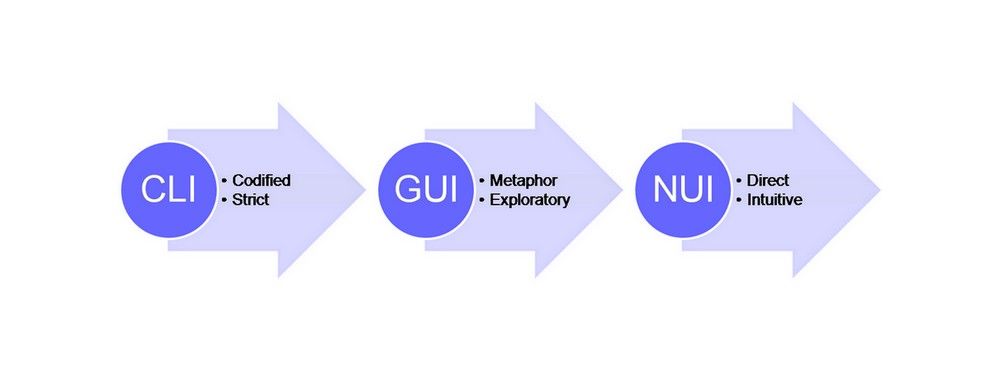
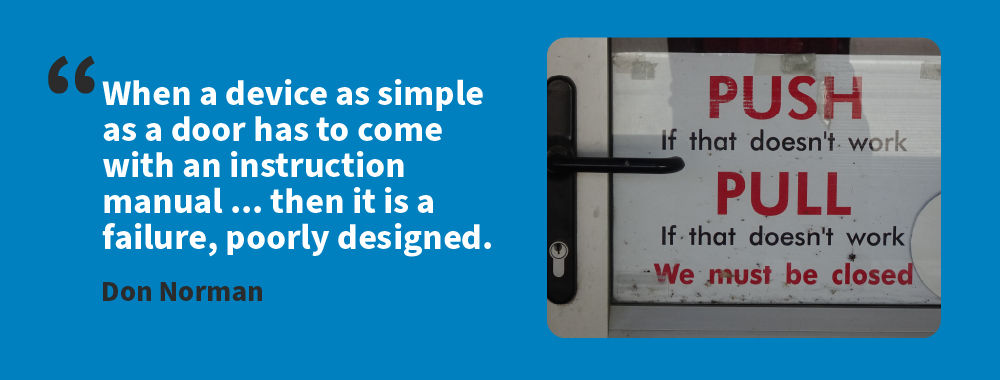

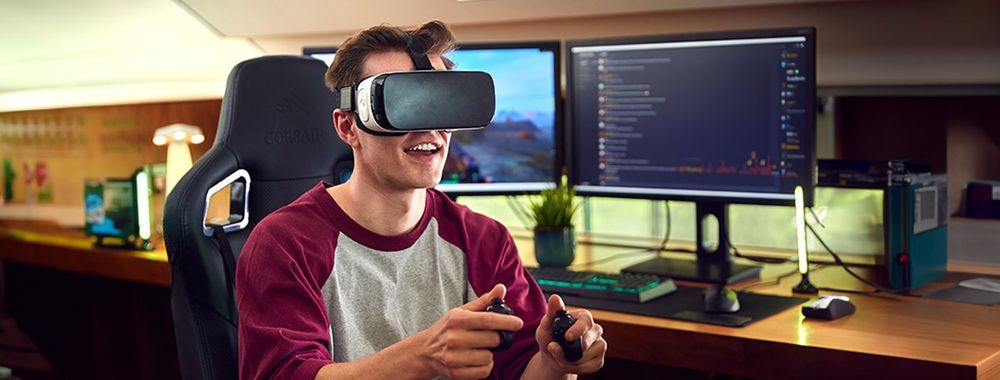
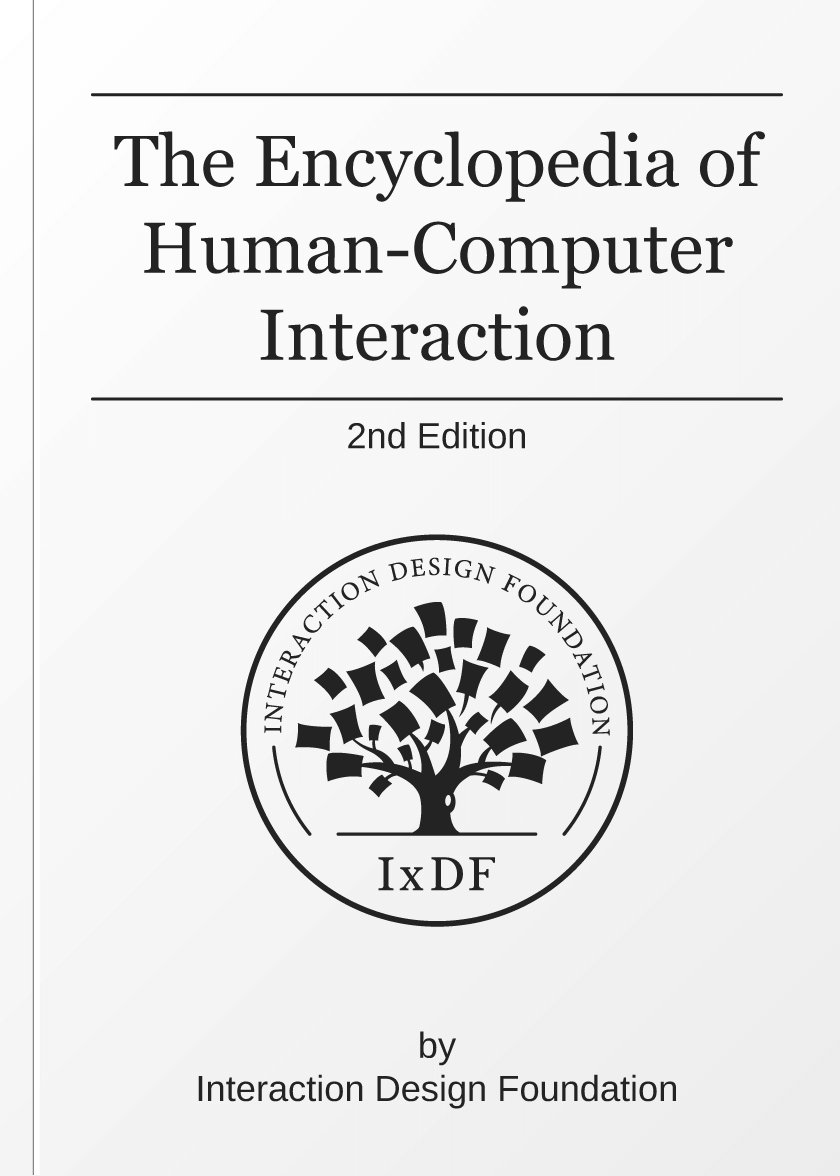



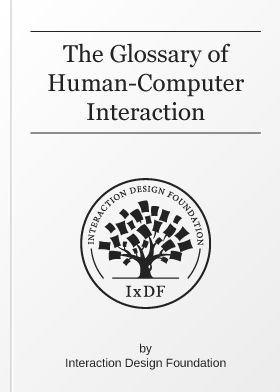





We believe in Open Access and the democratization of knowledge. Unfortunately, world-class educational materials such as this page are normally hidden behind paywalls or in expensive textbooks.
If you want this to change, , link to us, or join us to help us democratize design knowledge!
